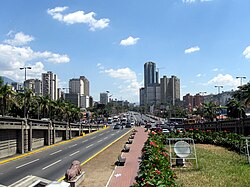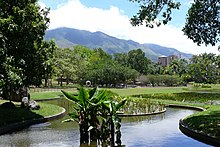Caracas
Caracas | |
|---|---|
City | |
| Santiago de León de Caracas | |
 Top left: Simón Bolívar Center; top right: Parque Central Complex; middle: Plaza Venezuela Fountain; bottom left: Plaza Bolívar; bottom right: Los Próceres Monument. | |
| Nickname(s): La Sultana del Ávila (The Avila's Sultana) La Sucursal del Cielo (Heaven's Branch on Earth) | |
| Coordinates: 10°30′N 66°55′W / 10.500°N 66.917°W | |
| Country | Venezuela |
| State | Venezuelan Capital District Miranda |
| Municipality | Libertador |
| Founded | 25 July 1567 |
| Founded by | Diego de Losada |
| Metropolitan | Municipalities: Libertador, Chacao, Baruta, Sucre, El Hatillo |
| Government | |
| • Type | Mayor-council |
| • Body | Alcaldía Metropolitana de Caracas |
| • Mayor | Antonio Ledezma (ABP) |
| Area | |
| • Metro | 1,930 km2 (750 sq mi) |
| Elevation | 900 m (3,000 ft) |
| Population (2009) | |
| • Density | 1,431.5/km2 (3,708/sq mi) |
| • Metro | 5,196,514 |
| Demonym(s) | caraqueño (m), caraqueña (f) |
| Time zone | UTC-04:30 (VST) |
| • Summer (DST) | UTC-04:30 (not observed) |
Caracas is the capital city of Venezuela. Santiago de Leòn de Losada founded the city in 1567. It is where Simon Bolivar was born. The city has nearly 6 million people, who live in the metropolitan area. Caracas is the center of the economical activity of the country and also hosts the main government offices of Venezuela.
After WW2 the city has experienced a huge growth, thanks to the oil revenues of the country. Nearly half a million Europeans immigrated to the city in the 1950s ( that had in those years only one million inhabitants) and so Caracas developed a typical western-European look in the new modern areas.
Geography[change | change source]

Caracas is contained entirely within a valley of the Venezuelan Central Range, and is separated from the Caribbean coast by a roughly 15-kilometer (9 mi) expanse of El Ávila National Park. The valley is relatively small and quite irregular, and the altitude varies from between 870 and 1,043 meters (2,854 and 3,422 ft) above sea level; the historic center lies at about 900 meters (3,000 feet) above sea level.[1] This, along with the rapid population growth, has profoundly influenced the urban development of the city.[2] The most elevated point of the Capital District, wherein the city is located, is the Pico El Ávila, which rises to 2,159 meters (7,083 feet).[1]
The main body of water in Caracas is the Guaire River, which flows across the city and empties into the Tuy River, which is also fed by the El Valle and San Pedro rivers, in addition to numerous streams which descend from El Ávila. The La Mariposa and Camatagua reservoirs provide water to the city.[3][4][5][6] The city is occasionally subject to earthquakes – notably in 1641 and 1967.
Geologically, Caracas was formed in the Late Cretaceous period, with much of the rest of the Caribbean, and sits on what is mostly metamorphic rock. Deformation of the land in this period formed the region.[7]
Climate[change | change source]
Caracas has a tropical savanna climate (Köppen: Aw); fresh due to the elevation and with two distinct seasons: the rainy season, and the dry season.[8]
| Climate data for Chacao, Caracas Venezuela 1961–2022 | |||||||||||||
|---|---|---|---|---|---|---|---|---|---|---|---|---|---|
| Month | Jan | Feb | Mar | Apr | May | Jun | Jul | Aug | Sep | Oct | Nov | Dec | Year |
| Record high °C (°F) | 34.0 (93.2) |
34.5 (94.1) |
35.5 (95.9) |
37.6 (99.7) |
36.9 (98.4) |
34.5 (94.1) |
35.9 (96.6) |
36.9 (98.4) |
35.2 (95.4) |
34.8 (94.6) |
32.9 (91.2) |
32.4 (90.3) |
37.6 (99.7) |
| Average high °C (°F) | 27.7 (81.9) |
27.4 (81.3) |
29.5 (85.1) |
30.2 (86.4) |
31.2 (88.2) |
30.5 (86.9) |
29.5 (85.1) |
29.0 (84.2) |
29.0 (84.2) |
29.0 (84.2) |
28.0 (82.4) |
27.4 (81.3) |
29.0 (84.3) |
| Daily mean °C (°F) | 20.3 (68.5) |
20.4 (68.7) |
22.1 (71.8) |
23.4 (74.1) |
23.6 (74.5) |
23.5 (74.3) |
22.5 (72.5) |
22.3 (72.1) |
22.2 (72.0) |
21.9 (71.4) |
21.5 (70.7) |
19.5 (67.1) |
21.9 (71.5) |
| Average low °C (°F) | 16.0 (60.8) |
16.5 (61.7) |
17.5 (63.5) |
17.1 (62.8) |
20.2 (68.4) |
20.2 (68.4) |
18.0 (64.4) |
18.0 (64.4) |
17.9 (64.2) |
17.6 (63.7) |
17.0 (62.6) |
17.0 (62.6) |
17.8 (64.0) |
| Record low °C (°F) | 4.5 (40.1) |
7.2 (45.0) |
4.7 (40.5) |
8.9 (48.0) |
11.1 (52.0) |
12.4 (54.3) |
12.6 (54.7) |
12.2 (54.0) |
11.0 (51.8) |
10.0 (50.0) |
7.7 (45.9) |
6.8 (44.2) |
4.5 (40.1) |
| Average precipitation mm (inches) | 5.3 (0.21) |
4.7 (0.19) |
9.9 (0.39) |
80.9 (3.19) |
143.5 (5.65) |
108.7 (4.28) |
130.3 (5.13) |
181.9 (7.16) |
177.0 (6.97) |
108.9 (4.29) |
60.9 (2.40) |
10.0 (0.39) |
1,022 (40.25) |
| Average precipitation days (≥ 1.0 mm) | 1 | 1 | 1 | 2 | 10 | 12 | 15 | 15 | 13 | 10 | 4 | 2 | 86 |
| Average relative humidity (%) | 71 | 66 | 62 | 60 | 67 | 75 | 74 | 73 | 76 | 78 | 77 | 75 | 71 |
| Mean monthly sunshine hours | 220.8 | 229.4 | 268.5 | 242.8 | 216.3 | 171.7 | 192.5 | 204.8 | 183.4 | 200.4 | 199.2 | 212.2 | 2,542 |
Source: https://es.climate-data.org/america-del-sur/venezuela/distrito-capital-149/. {{cite web}}: Missing or empty |title= (help)</ref>
| |||||||||||||
Sports[change | change source]
All the best teams of the sports done in Venezuela are concentrated in the metropolitan area of Caracas. Between those teams we have:
- baseball: Leones de Caracas
- football: Deportivo Italia; Deportivo Petare; Caracas FC.
Famous sites[change | change source]
- Avila National Park
- Humbolt Tramway
- Simon Bolivar Birthplace
- Caracas Cathedral
- Bolivar Square
- Altamira Square
- East Park
- Los Proceres
- Parque Central
- Centro Comercial Tamanaco
- Sambil Mall
Buildings[change | change source]
Many beautiful modern buildings can be seen in the city. Here there are some of them:

- Parque Central
 - Plaza Venezuela Buildings
- Plaza Venezuela Buildings- - Casa de Italia
 - Torre Britanica
- Torre Britanica - Torre La Previsora
- Torre La Previsora
References[change | change source]
- ↑ 1.0 1.1 Parsons, James J. (1982). "The Northern Andean Environment". Mountain Research and Development. 2 (3): 253–264. doi:10.2307/3673089. JSTOR 3673089.
- ↑ Morris, A.S. (1978). "Urban Growth Patterns in Latin America with Illustrations from Caracas". Urban Studies. 15 (3): 299–312. doi:10.1080/713702382. ISSN 0042-0980. S2CID 153430807.
- ↑ "Guaire River". Encyclopedia Britannica. Archived from the original on 31 October 2020. Retrieved 17 May 2020.
- ↑ Jaffe, Rudolf; Leal, Ivan; Alvarado, Jose; Gardinali, Piero; Sericano, José (1 December 1995). "Pollution effects of the Tuy River on the central Venezuelan coast: Anthropogenic organic compounds and heavy metals in Tivela mactroidea". Marine Pollution Bulletin. 30 (12): 820–825. Bibcode:1995MarPB..30..820J. doi:10.1016/0025-326X(95)00087-4. ISSN 0025-326X.
- ↑ Aloui, Fethi; Dinçer, İbrahim (22 August 2018). Exergy for a better environment and improved sustainability. 2, Applications. Cham, Switzerland. p. 716. ISBN 978-3-319-62575-1. OCLC 1049802575.
{{cite book}}: CS1 maint: location missing publisher (link) - ↑ Steward, Julian Haynes (1946). Handbook of South American Indians. U.S. Government Printing Office. p. 475. Archived from the original on 15 April 2021. Retrieved 17 May 2020.
- ↑ Dengo, Gabriel (1 January 1953). "Geology of the Caracas Region, Venezuela". GSA Bulletin. 64 (1): 7–40. Bibcode:1953GSAB...64....7D. doi:10.1130/0016-7606(1953)64[7:GOTCRV]2.0.CO;2. ISSN 0016-7606.
- ↑ https://es.climate-data.org/america-del-sur/venezuela/distrito-capital-149/.
{{cite web}}: Missing or empty|title=(help)






